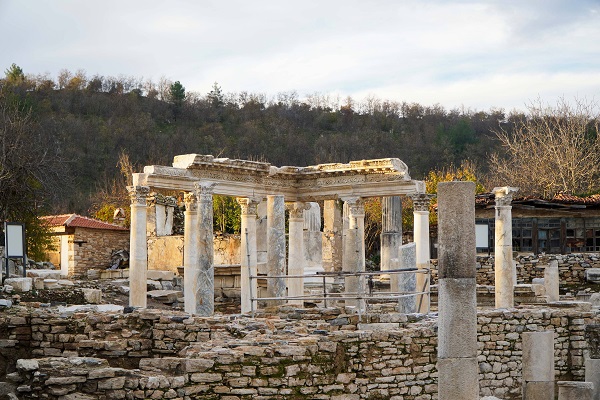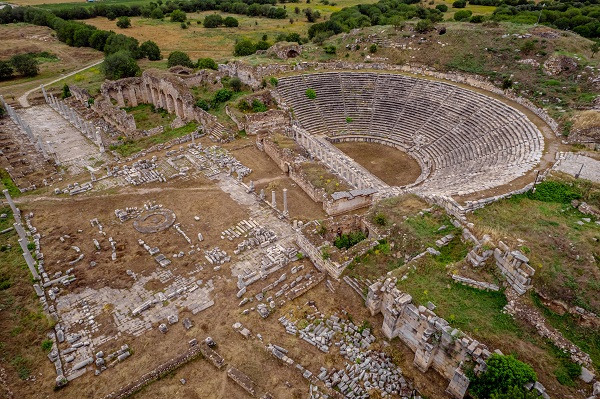Ridley Scott’s long-awaited Gladiator sequel captivates audiences worldwide with its spectacular fight scenes. Gladiators, swords, and action — what’s not to enjoy, right? But here’s an exciting twist: Did you know that Anatolia was once a popular location for gladiatorial contests, as depicted in the film? During the Roman period, Anatolia was instrumental in the spread of gladiatorial culture.
Today, Türkiye is surrounded by ancient cities where you can explore the traces of gladiators in Anatolia, from theatres that hosted games to artefacts depicting these warriors. With 2024 declared the “Golden Age of Turkish Archaeology,” ongoing excavations may reveal even more about these gladiators. So, why don’t you visit Türkiye and have an exciting adventure in Anatolia’s most famous gladiator cities?
Ephesus: Where It All Started
One of the first Anatolian cities to host gladiatorial contests was Ephesus, which was then the capital of Roman Asia. During contests in Ephesus, horns were blown before gladiator fights, and a festive atmosphere overtook. The traces of the gladiators can be seen today at the theatre and ruins of the stadium in the UNESCO heritage site of Ephesus, where they fought years ago. Gladiator graffiti adorns these structures’ walls, and the Ephesus Museum in İzmir houses day-to-day items such as oil lamps and tombstones with gladiator depictions. Also, the Ephesus Experience Museum hosts visitors who want to experience Ephesus’ daily life personally. A little reminder: During summer, people can visit Ephesus until midnight under enchanting lights thanks to Türkiye’s Night Museums Project.
Hierapolis: Where Rules Were Set
Hierapolis, a UNESCO World Heritage Site with adjacent Pamukkale travertines in Denizli, is attractive today with its well-preserved ruins. Known for its healing thermal waters throughout history, Hierapolis also showcases evidence of gladiatorial contests, from inscriptions to depictions, which can be seen at Hierapolis Museum. Two inscriptions even inform that the games were held with rules and overseen by referees in the city, which indicates a possible permanent gladiatorial organisation here.
Stratonikeia: Where Gladiators Were Trained
Sports were always so important for Muğla’s ancient city of Stratonikeia that they even built the largest gymnasium in antiquity. Accordingly, Stratonikeia has been known as “the city of gladiators” throughout the ages. It was a centre where gladiators were trained, did demonstrations and spent their lives after retirement. The city, recognised as one of the biggest marble cities worldwide, showcases graves and tombstones belonging to gladiators unearthed by archaeologists to date.
Aphrodisias: Where Crowds Cheered Gladiators
Aphrodisias in Aydın, another UNESCO site in Türkiye, was famous for its marble quarries, expert sculptors, and fine marble sculptures. However, the city’s stadium is also a wonder of ancient engineering, standing as one of the best-preserved Roman stadiums in the world. This massive structure, which could hold up to 30,000 spectators, was the venue of thrilling gladiatorial contests. Walking through its rows of stone seats, you can almost hear the echoes of cheering crowds and feel the adrenaline of ancient games. Tunnels through which gladiators entered and exited the arena have also been preserved here.
Kibyra: Where Gladiators Once Roamed
Kibyra was one of the most important cities of the Roman civilisation and the centre of Roman-taste entertainment like gladiator fights. At the entrance to the city is its stadium, which is believed to have hosted epic gladiator competitions – thus bequeathing Kibyra the title “city of gladiators”, like Stratonikeia. The most extensive collection of gladiator friezes from antiquity was also unearthed in Kibyra. In addition to these reliefs, visitors can see the monumental fountain, which started to flow again after a comprehensive restoration. ///nCa, 17 December 2024 (in cooperation with the Embassy of Türkiye to Turkmenistan)





